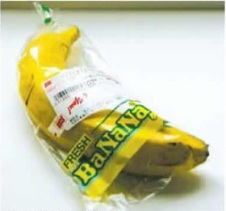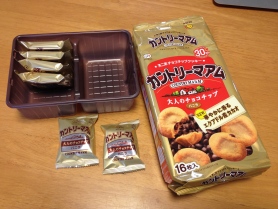Japan is widely known for its delicious food. The food culture here has been evolving over thousands of years, and each area in the country boasts wonderful local specialties. We are lucky to live in Nagasaki, a prefecture known for traditions rooted in Japanese and global cultures.
On this page, you’ll be able to learn about your options for buying, preparing, and enjoying food during your time in Nagasaki, Japan!
Where and How to Get Food in Japan
Want to eat cheap and healthy in Nagasaki? Not a problem!
Fruits and Vegetables
Produce sales in Japan are highly influenced by seasonal growth cycles. Generally, small produce shops will have better prices on in-season produce than chain grocery stores. Those who live in the countryside can take advantage of unmanned fruit and veggie stands to buy cheap produce as well. On the other hand, chain grocery stores offer more consistency in size, shape, color, and condition of produce.
Fruit, when bought year-round, can be incredibly expensive, so look out for seasonal deals. In Nagasaki prefecture, oranges and bananas tend to be affordable compared to other fruits. Frozen fruits are not too expensive when bought in large packages. Though not available in every area, restaurant supply stores such as A Price (in Nagasaki, Omura, Sasebo, and Isahaya) have cheap frozen fruits and vegetables sold in bulk.
See this chart by Ajinomoto to learn when various fruits and vegetables are in season in Japan.

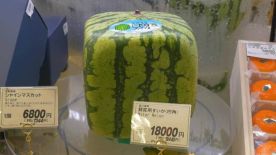
Meat and Fish
Like fruits and vegetables, meats and fish can generally be purchased for lower prices at local butchers and fish shops. Local butchers may also be able to help you when you are looking for a harder-to-find things, such as oxtail, whole chickens, or bones. At butchers, you will have to state (or point to) what you want and say how many grams you’d like. For example, “鶏むね、ひゃくグラムお願いします” (torimune, hyaku guramu onegaishimasu.) (100 grams of chicken breast, please!) Chain grocery stores will also have plenty to choose from in pre-packaged portions, so you can spend some time browsing before picking what you’d like.
Seasoning「さしすせそ」
In Japanese, this phrase used to describe the main ingredients used in Japanese cuisine.
さ is for 砂糖(sugar), し is 塩(salt), す is 酢(vinegar), せ is 醤油(soy sauce), and そ stands for 味噌(miso).
Dashi (出汁) is also commonly found in Japanese cuisine. Dashi is stock made by boiling ingredients such as dried mushrooms and fish flakes. Dashi is oftentimes not vegan or vegetarian friendly so please be careful. Wheat (komugi) (小麦) and gluten are used in a lot of Japanese foods as well. Checking the ingredients on your food packaging will be important if you have a gluten/wheat intolerance.
Cooking at Home
Cooking at home is a great way to practice your culinary skills and save money. You might notice that some of the ingredients you use back home are not easy to find. This could be a time to consider stepping out of your comfort zone and try cooking Japanese food. Not to mention, showing up to school with a bento you made yourself is sure to impress your coworkers!
-Website (Many languages available)
-YouTube channel (English, subtitles may be available)
-Let’s Cook Japanese! (English)
Prepared Meals
A prepared meal can really help you out after a long day of work. And, if you look around after 4pm, you can probably score some nice discounts, too!
-Grocery Stores
Grocery stores often sell a large variety of prepared foods. Cold foods like sandwiches and salads, bento you can throw in the microwave for a fast dinner, sides, cooked meats, and more. Just be careful – discerning nutrition and allergy info on these premade foods can be difficult. For “deli” style foods, for example, calories are sometimes not listed at all. And, if the label is on the bento is on the bottom of the container, it’s not like you can flip the poor thing upside down in the middle of the store.
-Bento Shops & Department Stores
Bento shops and individual shops on the food floor of large department stores can offer super fresh and extra delicious foods. But, this takeout-style can also make it difficult to understand nutrition and allergy information.
-Convenience Stores
Japanese convenience stores, or “conbini” in Japanese, offer a variety of different products from household goods, such as soap and disposable kitchenware to fresh, ready to eat meals. Their products also tend to have some English on the packaging, making it easy for a new ALT to know what they’re about to eat. While a little more expensive than other options, conbini can save you time and energy.
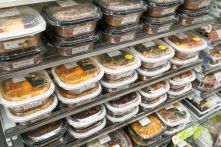
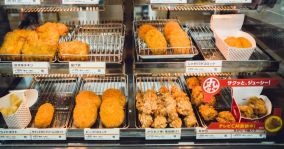
Conbini might be a favorite among ALTs, but just like any store, do be wary of salt and deep-fried foods. These foods have a large amount of oil that shouldn’t be eaten for every meal. Although the food is wonderful and convenient, you might wind up paying in higher costs and health consequences.
Food from Abroad
Check out our article on foreign foods to learn more. We all crave foods from home sometimes!
Substitutes and Allergy-Friendly Foods
These days, more and more stores and restaurants aim to serve customers with dietary restrictions. Below we have put together a resource with pictures and descriptions of substitutes and hard to find foods!
-Milk Substitutes
-Dairy Substitutes







-Bread Substitutes



-Gluten Free Substitutes
Check out this awesome guide by Fukuoka Eats! It’s so detailed and helpful.
-Halal Foods




Halal foods can also be ordered online at websites like Ajinatori Halal and Said Shop Halal Foods.
You can also learn more at the Halal Media Japan and Halal in Japan websites.
For more information, check out our Veganism and Dietary Restrictions Page!
How to read labels and allergy information.
Nutrition Table – 栄養成分表示 (えいようせいぶんひょうじ) (eiyou seibun hyouji)
Nutrition Tables are required on all packaged food products in Japan.
5 basic nutrients are always listed on the Nutrition Table. Other nutrients may also be listed.
More information – Nutrition Table
|
エネルギー |
calories |
kcal (calories) |
|
たんぱく質 |
proteins |
g (grams) |
|
脂質 |
fats |
g |
|
炭水化物 |
carbohydrates |
g |
|
食塩相当量 |
sodium |
g |
Product Name – 品名 (ひんめい) (hin mei)
Ingredient List – 原材料名 (げんざいりょうめい) (gen zairyou mei)
Ingredients are listed in order of highest to lowest concentration.
More information – Ingredient List
Sometimes a message such as “written on flap” or “printed on bottom left” is written in Japanese instead of the date.
Will state if a product must stay refrigerated or frozen, kept in a dry place, kept away from light, etc.
Allergens may be listed in plain text or in a table on food packaging. National law dictates eight allergens which must be listed if present. There are also 20 other commonly listed allergens.
More information – Allergens
8 mandatory reported allergens – always listed if present
えび、かに、くるみ(※)、小麦、そば、卵、乳、落花生(ピーナッツ)
shrimp, crab, walnut, wheat, soba (buckwheat), egg, milk, peanuts
20 recommended reported allergens – may or may not be listed if present
アーモンド、あわび、いか、いくら、オレンジ、カシューナッツ、キウイフルーツ、牛肉、ごま、さけ、さば、大豆、鶏肉、バナナ、豚肉、まつたけ、もも、やまいも、りんご、ゼラチン
almond, abalone, squid, fish egg, orange, cashew nut, kiwi, beef, sesame, alcohol, mackerel, soy, banana, pork, matsutake mushroom, peach, yamaimo yam, apple, gelatin
I’m not sure if I can read all of this information in Japanese… Any tips?
- A smartphone application, such as Google Lens, which uses the camera to detect and automatically translate text can help. However, translations are not always accurate, so please exercise caution especially when checking for allergens.
- A very helpful guide to reading labels can be found on isitveganjapan.com.
- People with dietary restrictions don’t have to learn every single kanji; just scan for 魚(fish), 肉(meat), 豚(pig), 牛(cow), 卵(egg), 玉子(egg), 乳(milk), 蜂蜜 or はちみつ(honey).
- Note: If a larger kanji has the 魚 kanji in it, for example 鰹, you can see that it is a type of fish (or whale), even if the rest of the kanji is different.
- 乳化剤 (にゅうかざい) means emulsifier, so even though it has the 乳 (milk) kanji in it, it is non necessarily non-vegan (though some emulsifiers are of animal origin).
梅肉(ばいにく)means plum paste, so it is vegan even though it has the 肉(meat).
Communicating Your Dietary Needs
Whether you’re at work, with friends, at a restaurant – wherever – these tips will help you communicate your dietary needs. (Tip: If remembering the words to put in the blanks is difficult, keep them in the notes app on your phone and show it while you’re speaking!)
Allergies
The phrase “I can’t eat XYZ” in Japanese can sometimes indicate strong dislike for a food, rather than an actual inability to eat it. If you use the word allergy (アレルギー) when communicating your needs, there will be no room for misunderstanding.
I have a _____ allergy.
_____ アレルギーがあります。
_____ arerugii ga arimasu.
Is ______ in this?
これに ______ がはいっていますか。
kore ni ______ ga haitte imasu ka?
Religious and Personal Needs
The following phrase can be used to describe your religious or personal beliefs.
I am _______. (Muslim, Hindu, Jewish, etc.) (vegan, vegetarian, etc.)
私は ______ です。
watashi wa ______ desu.
Now, the person you’re talking to may not know the specific dietary needs which come with your religion or personal beliefs. Here are some phrases which can help you explain.
I mustn’t eat ______.
(私は)______を食べてはいけません。
(watashi wa) ______ o tabete wa ikemasen.
______ is also not okay.
______ もだめです。
______ mo dame desu.
I only eat ______.
______しか食べません。
______ shika tabemasen.
______ is alright (for me to eat.)
______は大丈夫です。
______ wa daijoubu desu.
Local Perspective: Dietary Needs at Restaurants
Local Perspective: Is Fish, Meat?
Local Perspective: What About Gluten?
Food Waste and Packaging
Restaurants and Gatherings
In Japan, people are taught to finish the food put in front of them from a young age. An unfinished meal can communicate to the cook that you didn’t like something, even if you were actually too full to finish. Be it for manners or for your budget, it is best to only order what you know you can finish at restaurants. If you’re at a party or gathering and you are serving yourself, only take what you will finish and be mindful of the people around you. Only get seconds after everyone has been able to take their fair share.
Grocery stores
Plastic bags are not free in most Japanese stores, so you will be asked about plastic bags at the checkout counter often. Whether you brought your own eco-bag (yay!) or you need a plastic bag, here’s how you might go about navigating that conversation:
Do you need a bag?
袋はどうされますか。
fukuro wa dou saremasu ka?
Yes, please.
お願いします。
onegai shimasu.
No, thank you.
大丈夫です。
daijoubu desu.
Packaging Waste
Sometimes the level of packaging on grocery items can feel excessive in Japan. But, culturally, packaging communicates care and intention behind the presentation of an item. It can be a challenge, especially if you like cookies and other items that are often sold with the idea of being a gift instead of for individual consumption. It’s not always possible to have no extra packaging whatsoever, but we can all do our part to help the environment by being extra vigilant when we shop and to also dispose of packaging properly when we’re done with it.
